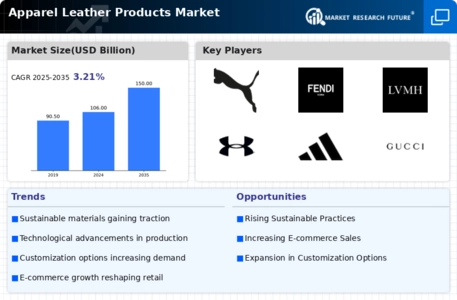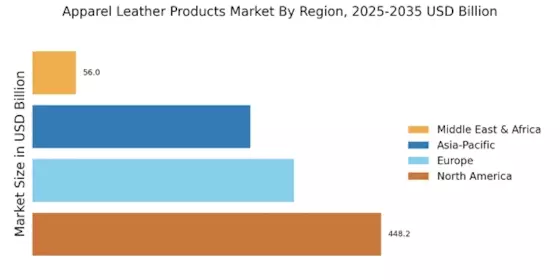Rising Demand for Luxury Goods
The Apparel Leather Products Market is experiencing a notable increase in demand for luxury goods, driven by a growing affluent consumer base. As disposable incomes rise, consumers are increasingly willing to invest in high-quality leather apparel, which is perceived as a status symbol. This trend is particularly evident in regions where economic growth is robust, leading to a projected market growth rate of approximately 5% annually. The luxury segment of the apparel leather products market is expected to expand, as consumers seek unique and premium offerings that reflect their personal style and social status. This shift towards luxury leather products is likely to bolster the overall market, as brands respond by enhancing their product lines to cater to this discerning clientele.
Sustainability and Ethical Sourcing
Sustainability has emerged as a pivotal driver within the Apparel Leather Products Market, as consumers increasingly prioritize ethical sourcing and environmentally friendly practices. Brands are now compelled to adopt sustainable methods in their production processes, which includes using eco-friendly tanning techniques and sourcing leather from responsible suppliers. This shift is not merely a trend; it reflects a broader societal movement towards sustainability, with a significant portion of consumers willing to pay a premium for products that align with their values. The market for sustainable leather products is projected to grow, potentially reaching a valuation of several billion dollars in the coming years. As awareness of environmental issues continues to rise, the demand for sustainable apparel leather products is likely to increase, influencing brand strategies and consumer purchasing decisions.
Cultural Influences and Fashion Trends
Cultural influences and evolving fashion trends are significant drivers within the Apparel Leather Products Market. The increasing globalization of fashion has led to a blending of styles and preferences, with leather apparel becoming a staple in various cultural contexts. Fashion weeks and celebrity endorsements play a pivotal role in shaping consumer preferences, often leading to spikes in demand for specific leather products. As trends shift, brands must remain agile and responsive to these changes to maintain relevance in the market. The influence of social media cannot be overlooked, as it amplifies fashion trends and drives consumer engagement. This dynamic environment suggests that brands that effectively leverage cultural insights and fashion trends may gain a competitive edge in the apparel leather products market.
E-commerce Growth and Online Retailing
The rise of e-commerce is significantly impacting the Apparel Leather Products Market, as more consumers turn to online platforms for their shopping needs. The convenience of online shopping, coupled with the ability to access a wider range of products, is driving this trend. In recent years, online sales of leather apparel have surged, with estimates suggesting that e-commerce could account for over 30% of total sales in the apparel sector by 2026. This shift is prompting traditional retailers to enhance their online presence and invest in digital marketing strategies to capture this growing consumer segment. As e-commerce continues to expand, it is likely to reshape the competitive dynamics of the apparel leather products market, compelling brands to innovate in their online offerings.
Technological Advancements in Production
Technological advancements are playing a crucial role in shaping the Apparel Leather Products Market. Innovations in manufacturing processes, such as automated cutting and sewing, are enhancing efficiency and reducing production costs. Additionally, the integration of digital technologies, including 3D printing and virtual fitting rooms, is transforming how consumers interact with leather apparel. These advancements not only streamline production but also allow for greater customization, catering to the growing consumer demand for personalized products. The market is witnessing a shift towards more innovative and tech-driven solutions, which could potentially lead to a more competitive landscape. As brands adopt these technologies, they may enhance their market position and appeal to a tech-savvy consumer base.


















Leave a Comment